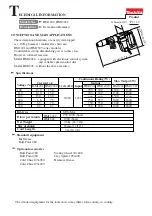
BOP HIPWR 080709
3-57
3.6.4
PROGRAM MESSAGE STRUCTURE
SCPI program messages (commands from controller to power supply) consist of one or more
message units
ending in a
message terminator
. The message terminator is not part of the syntax; it
is defined by the way your programming language indicates the end of a line (“newline” charac-
ter). Sending a character with EOL line asserted is another way of sending a message termina-
tor. The message unit is a keyword consisting of a single command or query word followed by a
message terminator (e.g., CURR?<newline> or TRIG<end-of-line>). The message unit may
include a data parameter after the keyword separated by a space; the parameter is usually
numeric (e.g., CURR 5<newline>), but may also be a string (e.g., OUTP ON<newline>). Figure
3-19 illustrates the message structure, showing how message units are combined. The follow-
ing subparagraphs explain each component of the message structure.
NOTE: An alternative to using the message structure for multiple messages defined in the fol-
lowing paragraphs is to send each command as a separate line. In this case each com-
mand must use the full syntax shown in Appendix B.
3.6.4.1
KEYWORD
Keywords are instructions recognized by a decoder within the BOP, referred to as a “parser.”
Each keyword describes a command function; all keywords used by the BOP are listed in Figure
3-18.
Each keyword has a long form and a short form. For the long form the word is spelled out com-
pletely (e.g. STATUS, OUTPUT, VOLTAGE, and TRIGGER are long form keywords). For the
short form only the first three or four letters of the long form are used (e.g., STAT, VOLT, OUTP,
and TRIG). The rules governing short form keywords are presented in Table 3-21.
You must use the rules above when using keywords. Using an arbitrary short form such as
ENABL for ENAB (ENABLE) or IMME for IMM (IMMEDIATE) will result in an error. Regardless
of which form chosen, you must include all the letters required by that form.
To identify the short form and long form in this manual, keywords are written in upper case let-
ters to represent the short form, followed by lower case letters indicating the long form (e.g.,
IMMediate, EVENt, and OUTPut). The parser, however, is not sensitive to case (e.g., outp,
OutP, OUTPUt, ouTPut, or OUTp are all valid).
3.6.4.2
KEYWORD SEPARATOR
If a command has two or more keywords, adjacent keywords must be separated by a colon (:)
which acts as the keyword separator (e.g., CURR:LEV:TRIG). The colon can also act as a root
specifier (paragraph 3.6.4.7).
TABLE 3-21. RULES GOVERNING SHORTFORM KEYWORDS
IF NUMBER OF LETTERS IN
LONGFORM KEYWORD IS:
AND FOURTH LETTER
IS A VOWEL?
THEN SHORT FORM
CONSISTS OF:
EXAMPLES
4 OR FEWER
(DOES NOT MATTER)
ALL LONG FORM LETTERS
MODE
5 OR MORE
NO
THE FIRST FOUR
LONG FORM LETTERS
MEASure, OUTPut, EVENt
YES
THE FIRST THREE
LONG FORM LETTERS
LEVel, IMMediate, ERRor
Содержание BOP 1000W
Страница 2: ......
Страница 10: ......
Страница 20: ......
Страница 31: ......
Страница 32: ......
Страница 36: ......
Страница 50: ...FIGURE 2 2 LOAD CONNECTIONS LOCAL SENSING...
Страница 53: ......
Страница 54: ......
Страница 55: ......
Страница 56: ......
Страница 57: ......
Страница 61: ...FIGURE 2 11 POWER ON DEFAULT SCREEN FOR SLAVE UNIT 2 8 4 OPERATING INSTRUCTIONS FOR MULTIPLE UNIT COMBINATIONS...
Страница 63: ...080709 C 25 FIGURE 2 12 3 X 2 3 SERIES X 2 PARALLEL CONFIGURA TION LOCAL SENSING TYPICAL 2 25 2 26 Blank 24 25...
Страница 64: ......
Страница 68: ...FIGURE 3 3 POWER UP SCREEN SHOWING GRAPHIC METERS VOLTAGE 0000 0...
Страница 125: ......
Страница 128: ......
















































